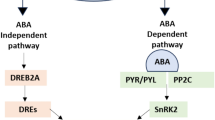Abstract
We have previously shown that fungicide Mancozeb causes a 50% decrease in Bradyrhizobium sp USDA 3187 growth rate and affects the bacteria-root symbiotic interaction. In order to elucidate the fungicide toxicity mechanism we determined the effects of Mancozeb on cell chemical composition, glutathione (GSH) content (molecule involved in the detoxification process), glutathione S-transferase (GST) activity and on polyamine, exopolysaccharides, capsular polysaccharides and lipopolysaccharides. Mancozeb produced biochemical alterations in membrane composition, polysaccharides and polyamines. In spite of the increment of GSH content and GST activity, they are not enough to prevent the growth diminution.
Similar content being viewed by others
References
Abe M, Sherwood J, Hollingsworth R & Dazzo F (1984) Stimulation of clover root hair infection by lectine-binding oligosaccharides from the capsular and extracellular polysaccharides of Rhizobium trifolii. J. Bacteriol. 160: 517–520
Appanna V (1988) Alteration of exopolysaccharide composition in Rhizobium meliloti JJ1 exposed tomanganese. FEMS Microbiol. Lett. 50: 141–144
Bradford M (1976) A rapid and sensitive method for the quantitation of microgram quantities of protein utilizing the principle of protei-dye binding. Anal. Biochem. 72: 248–254
Breedveld W, Zevenhuizen L, Canter Cremers H & Zehnder A (1993) Influence of growth conditions on production of capsular and extracellular polysaccharides by Rhizobium leguminosarum. Antonie van Leeuwnhoek 64: 1–8
Carranza M, Rosas S & Ghittoni N (1986) Molecular composition of Rhizobium meliloti when parathion was added to the start of incubation. J. Appl. Bacteriol 60: 9–12
Casella S, Frassinetti S, Lupi F & Squartini A (1988) Effect of cadmium, chromium and copper on symbiotic and freeliving Rhizobium leguminosarum biovar trifolii. FEMS Microbiol. Lett. 49: 343–347
Castro S, Vinocur M, Permigiani M, Halle C, Taurian T & Fabra A (1997) Interaction of the fungicide Mancozeb and Rhizobium sp in pure culture and under field conditions. Biol. Fertil. Soils 25: 147–151
Curley R & Burton J (1975) Compatibility of Rhizobium japonicum with chemical seed protectants. Agron. J. 67: 807–808
Dodge J & Phillips G (1967) Composition of phospholipids and of phospholipid fatty acids and aldehydes in human red cells. J. Lipid Res 8: 667–670
Fabra A, Mori G, Ghittoni N, Evangelista A & Duffard R. (1987) Effects of 2,4D on Rhizobium sp in pure culture. Toxicity Assessment 2: 217–228
Fabra A, Giordano W, Rivarola V, Mori G, Castro S & Balegno H (1993) The interaction of 2,4D and polyamines in Azospirillum brasilense. Toxicology 83: 9–29
Flores H & Galston A(1982) Analysis of polyamines in higher plants by high performance liquid chromatography. Plant Physiol. 69: 701–704
Fuhijara S & Yoneyama T (1993) Effects of pH and osmotic stress on cellular polyamine contents in the soybean Rhizobium fredii P220 and Bradyhizobium japonicum A1017. Appl. Environm. Microbiol. 59: 1104–1109
Fujihara S & Yoneyama T (1994) Response of Rhizobium fredii P220 to osmotic shock: interrelationships between K+, mg2+, glutamate and homospermidine. Microbiology 140: 1909–1912
Garda H & Brenner R (1985) In vitro modification of cholesterol content of rat liver microsomes. Effects upon membrane fluidity and activity of glucose-6-phosphatase and fatty acid desaturation systems. Biochem. Biophys Acta 819: 45–54
Hebbar K, Gueniot, Heyraud A, ColinMorel P, Heulin T, Balandreau J & Rinaudo M (1992) Characterization of exopolysaccharides produces by rhizobacteria. Appl. Microbiol. Biotechnol. 38: 248–253
Heinonen-Tanski H, Oros G & Kecsk & #x00E9;s M (1982) The effect of soil pesticides on the growth of red clover rhizobia. Acta Agric. Scand. 32: 283–288
Kates M (1972) Techniques of Lipidology pp 421. Work T & Work E (Ed) American Elsevier New York
Kucharek T (1982) Effect of Chloroneb seed treatment on soybean yield and nodulation. Soil and Crop Society of Florida 41: 59–62
Mallik M & Tesfai K (1983) Compatibility of Rhizobium japonicum with commercial pesticides in vitro. Bull. Environm. Contam. Toxicol. 31: 432–437
Matkovics B, Kecskementi V, Varga S, Novak Z & Kertesz Z (1993) Antioxidant properties of diand polyamines. Comp. Biochem. Physiol. 104b: 475
Meister A (1988) Glutathione metabolism and its selective modification. J. Biol. Chem. 263: 17205–17210
Moorhouse K & Casida J (1992) Pesticides as activators of mouse liver microsomal glutathione Stransferase. Pest. Biochem. Physiol. 44: 83–90
Ruiz-Sainz J, Beringer J & GutierrezNavarro A (1984) Effect of the fungicide captfol on the survival and symbiotic properties of Rhizobium trifolii. J. Appl. Bacteriol. 57: 361–367
Sasano H, Miuazaki S, Shiga K, Goukon Y, Nishihira T & Nagura H (1993) Glutathione Stransferase in human esophageal carcinoma. Anticancer Res. 13: 363–368
Sedlak J & Lindsay R (1968) Estimation of total, protein bound, and nonprotein sulfhydryl groups in tissue with Ellman & #x2019;s reagent. Anal. Biochem. 25: 192–205
Skorupska A, Derylo M & Lorkiewicz Z (1985) Role of noncarbohydrate substitutions of Rhizobium exopolysaccaride in nodulation process. Arch. Microbiol. 143: 307–310
Smith T & Best G (1977) Polyamines in barley seedlings. Phytochemistry 16: 841–843
Torstensson L (1975) Effects of Bentazon and Dinoseb on soil microorganisms and on the RhizobiumLeguminosae symbiosis. Swedish J. Agric. Res. 5: 177–183
Trevelyand W & Harrison J (1952) Yeast metabolism I Fractionation and microdetermination of cell carbohydrates. Biochem. J. 50: 298–301
Tu C (1981) Influence of pesticide seed treatments on Rhizobium japonicum and symbiotically grown soybean in soil under laboratory condition. Prot. Ecol. 3: 41–46
Vance C (1983) Rhizobium infection and nodulation: a beneficial plant disease? Ann. Rev. Microbiol. 37: 399–403
Vessey D & Boyer T (1984) Differential activation and inhibition of different forms of rat liver glutathione Stransferase by the herbicide 2,4D and 2,4,5T. Toxicol. Appl. Pharmacol. 73: 492–497
Vincent JM (1970) A manual for the practical study of rootnodule bacteria. IBP Blackwell Scientific Publications, Oxford
Westphal O & Jann K (1965) Bacterial lipopolysaccharides in Rhizobium leguminosarum. In:Whistel (Ed) Methods in Carbohydrates Chemistry Vol 5 p83–87. Accademic Press, New York
Author information
Authors and Affiliations
Rights and permissions
About this article
Cite this article
Fabra, A., Angelini, J., Donolo, A. et al. Biochemical alterations in Bradyrhizobium sp USDA 3187 induced by the fungicide Mancozeb. Antonie Van Leeuwenhoek 73, 223–228 (1998). https://doi.org/10.1023/A:1000987524112
Issue Date:
DOI: https://doi.org/10.1023/A:1000987524112




